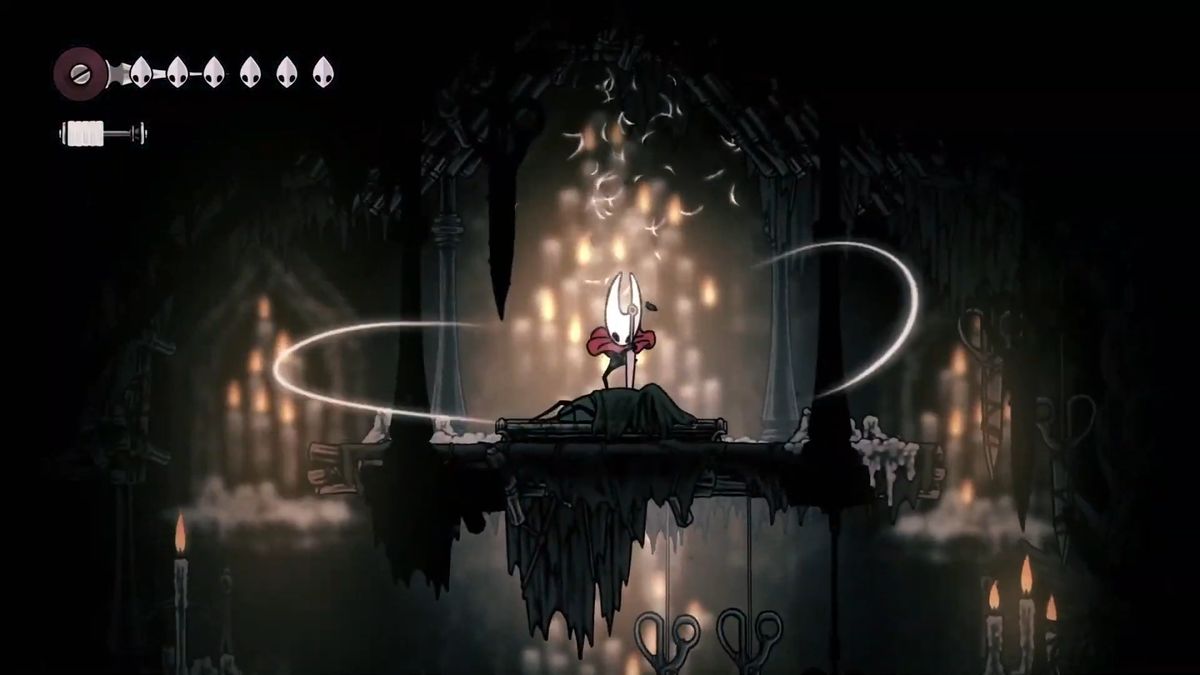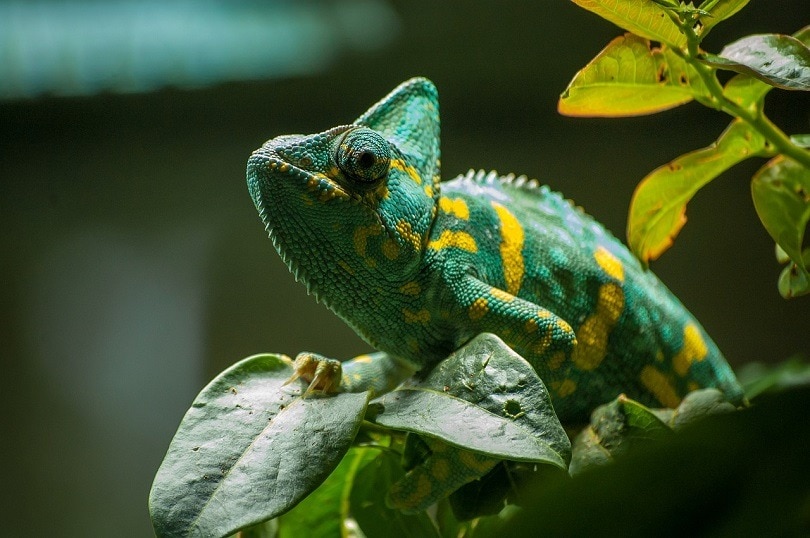

Chameleons are considered a somewhat challenging pet to own because they have very specific care requirements. However, if you have some experience of lizard keeping or you are up to the challenge, they can be fascinating and enthralling in equal measure.
These lizards should be kept alone and they typically need a large terrarium with a lot of foliage inside. They also need adequate lighting and heating, are fed live insects as well as leafy greens and supplements, and they usually prefer not to be held.
Read on to determine whether a chameleon is the right pet for you, and what you need to provide in order to ensure your pet chameleon is well cared for.

Chameleon Facts
There are 171 separate species of chameleon ranging from the tiny leaf chameleon that only grows to half an inch, to the Parson’s chameleon which can reach a length of nearly 30 inches. Chameleons are unique because they continue to grow throughout their lives and, while they do shed their skins, they only shed them in pieces rather than in a single attempt.
Chameleons are, of course, known for their ability to change color. This species of lizard is indeed able to change its color, but people mistakenly believe that they do this to match their surroundings. In reality, chameleons change their color according to various factors including a change in temperature, different environments, and even their mood. Dominant males may also have brighter and, therefore, more dominant colors. Females change their color according to how receptive they are of a particular chameleon suitor.
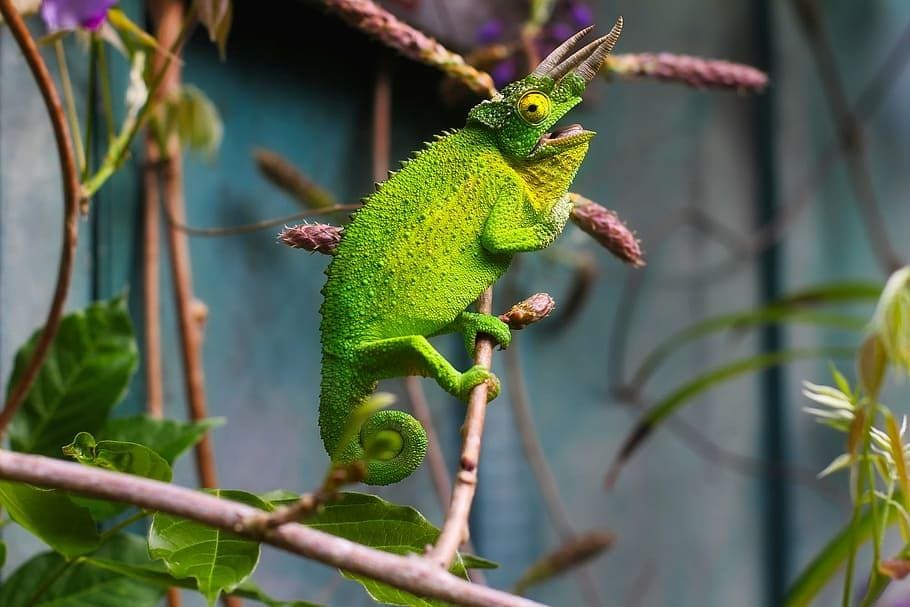
In the wild, chameleons are found in Africa, Asia, and Europe. They are typically found in arid regions, rainforests, savannas, and although most prefer to live in trees and bushes, some adapt to live happily on the ground. As a chameleon pet parent, you will need to provide a habitat and conditions that closely mimic their wild living conditions to ensure that your chameleon is safe, healthy, and happy.
Are Chameleons Good Pets?
As fascinating as these lizards are, they do not necessarily make the best pets. Although some chameleons may learn to put up with being held, they do not truly enjoy it, and most of these lizards prefer to be left alone and not handled. They also take quite a lot of care, require good quality and large terrariums, and they need to be fed live food as well as leafy greens.
Although the chameleon does have the benefit of being a diurnal animal, which means that it sleeps at night and is awake during the day, it can be quite a shy creature and will usually prefer to hide in its foliage rather than take center stage and attract the attention of its human family.
As well as being solitary animals that do not mix well with other chameleons, and hiding in their foliage, the chameleon does not run around or do much, except when eating.
If you’re happy with a pet that you can admire from afar, then the chameleon is worth the effort.
Where Can I Get a Pet Chameleon?
Chameleons are fairly common lizard pets and they can be found in reptile stores and on reptile websites.
Breeders can be found on recognized reptile dealing websites, and you may also find details in your local vet’s office, pet, or pet supply store.
Before contacting breeders, ensure that you know the exact species of chameleon you want. There is a big discrepancy in the costs of different species, and different ones do have different requirements and care levels, diets, and more.

The complicated care requirements and the minimal contact that chameleons have with their owners mean that they can be found in rescues, so check local adoption shelters.

How Much Does It Cost To Own a Pet Chameleon?
Initially, you will need to pay for the chameleon itself, with prices ranging from around $100 upwards. Some rarer breeds can cost several hundred dollars to purchase.
You will also need to buy a good quality terrarium, and this can prove expensive with a chameleon. Chameleons are arboreal, which means that they prefer to live up trees and spend time on elevated perches, rather than living on the ground. Expect to pay at least $100 to $200 for the terrarium.
Chameleons need heaters, lights, thermostats, heat mats, misters, and other equipment. The cost of these products soon adds up. You should expect to pay anywhere from around $300 to $1,000 depending on the breed of chameleon and the setup that you purchase.
Some kits are available, and these claim to offer everything you need for a basic chameleon setup, but be prepared to buy some extra items.
You will also need to get some food in. Chameleons eat a combination of leafy greens and gut-loaded insects and these will cost the equivalent of a few dollars a week.
You can get specialist insurance and wellness packages for chameleons, costing $10 per month up to around $20. Alternatively, vet visits can cost anywhere up to $200 or more.
All in all, you should budget approximately $700 for the chameleon and initial setup and an additional $40 to $50 per month for ongoing costs.
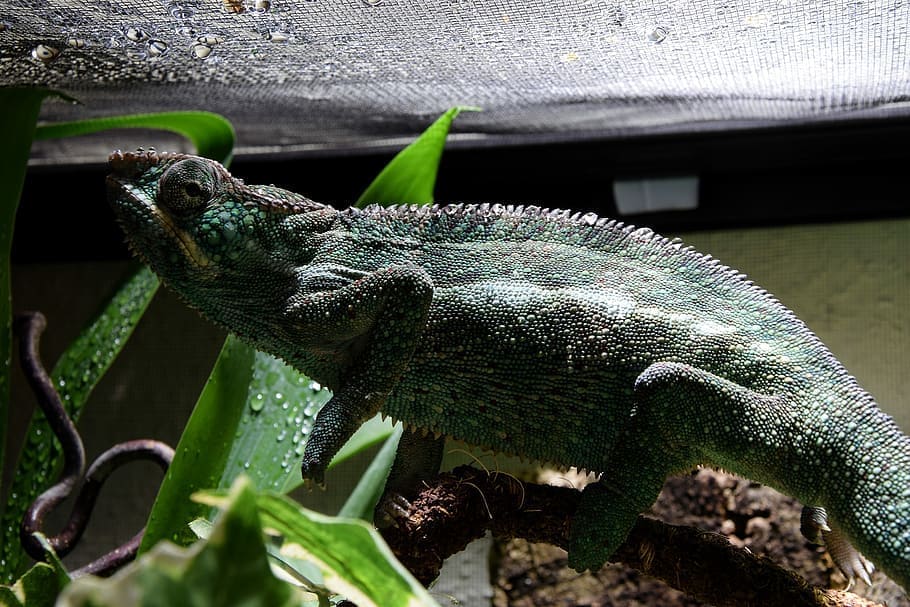
What Kind of Home Does My Pet Chameleon Need?
A terrarium should measure 3’ x 3’x 4’, at least, but there is no such thing as too large a home, at least as far as the chameleon is concerned.
The cage should be mesh-covered on three sides so that the chameleon can grab onto the side and hang without causing injury to its toes.
Provide branches for your chameleon to sit and hang in. Ensure that the plants are not dangerous or toxic and that there are plenty of layers and areas where your lizard can sit and hang out.
The bottom of the tank needs a sandlike substrate, although this can be moss or another suitable flooring material. The substrate should be fine. Particles that are too large can be swallowed with live food and this can lead to impaction and other gastrointestinal problems.
Chameleons are unlikely to take water from a bowl but will drink water droplets on leaves and foliage. You can provide a shallow water bowl, and this can help maintain appropriate humidity levels, but you should mist the foliage in the terrarium regularly so that your lizard has plenty of water to drink.
Your little lizard will require UVA and UVB rays and will benefit from natural sunlight through a window. They need 10 hours of UVB light a day.
Although the majority of your chameleon’s diet will come from live insects, and these will be gut-loaded with supplements, you will also provide some vegetables and leafy greens. As such, you will need at least one food bowl.
What Should I Feed My Pet Chameleon?
In the wild, a chameleon would eat everything from worms to slugs and snails. In captivity, they will eat a combination of feeder insects as well as some fruit and vegetables. You will also need to provide supplementation to ensure that your lizard is getting all the vitamins and minerals that they need in their diet.
Feeder Insects
Feeder insects include crickets, a variety of types of worms, cockroaches, locusts, stick insects, and even some flies. Some species, like morio worms, are considered too high in calories and fat content to be fed regularly but they may be fed as an occasional treat.
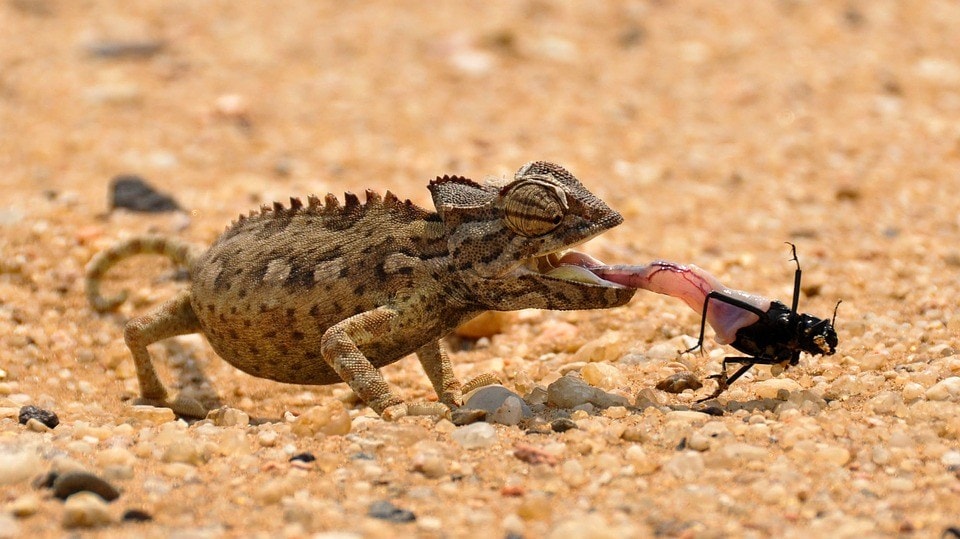
You should only feed insects that are as long as the chameleon’s head is wide. While you can offer feeders daily, you may only need to feed every other day, and you should offer between five and eight crickets per feeding.
Chameleons are insectivores, which means that they get their protein from the feeders. You can also gut load them with leafy vegetables like kale and fruit like oranges. This gut loading ensures that the protein you give to the crickets makes its way into the diet and stomach of your cham.
Other Food
You can feed some leafy greens, fruit, and vegetables as a supplemental addition to your cham’s diet. This can help get iron and other essential vitamins, but as long as you are gut loading and feeding adequate insects, this shouldn’t be necessary.

How Do I Take Care of My Pet Chameleon?
Chameleons are considered a tricky little lizard to look after, but if you’re willing to invest some money for the initial setup and time for the ongoing care and maintenance, they can make an excellent and very enjoyable pet. General care requires:
Handling
Chameleons have a lot going for them. They are beautiful to look at, they can change color according to factors like their mood and their environment, and they vary greatly in size. However, they are not usually tolerant of being held and handled. Some may put up with being picked up, but they will not enjoy the experience and they prefer to be left alone and admired from a distance. If you’re looking for a pet that you can pick up and handle, maybe look at a different lizard.
Shedding
The chameleon is a reptile and does shed its skin. They shed more often when they are young and less often as they age. Unlike snakes and some lizards, which shed all of their skin in a single go, the chameleon is more likely to shed in small pieces or sections.
You should maintain good humidity and an adequate diet to ensure stress-free molting for your little one, and this will require that you mist the plants more often.
Brumation
Because chameleons hail from tropical regions, they should not need to brumate, and if your cham is doing so, it may mean that you need to address the living conditions to ensure that temperatures and other factors are right.
Cleaning the Terrarium
Chameleons are not especially dirty reptiles, but they do relieve themselves, and they also have live food in their terrarium. The feeder insects can make their own mess, while half-eaten insects can rot and make a mess in the cage.
Clean the terrarium thoroughly every week, paying particular attention to the floor and cleaning all elements of the terrarium.
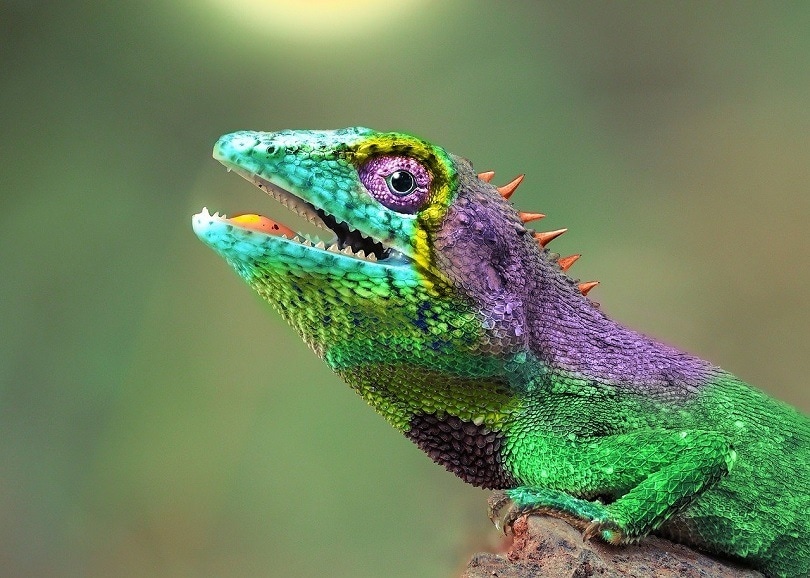
How Do I Know If My Pet Chameleon Is Sick?
One of the easiest ways to determine if a chameleon is sick is through its color. Most variants are known for their especially bright and bold colors. If your chameleon is a brown or grey color, could be stressed or it may have some physical illness or condition that needs to be dealt with.
Common illnesses include:
- Stress – Chameleons do not really like to be picked up and held and they can become easily stressed if they are startled or scared. In fact, stress is a major cause of illness in chams. You should reduce stress levels by putting them somewhere with minimal noise and little passing traffic. Prevent other animals like dogs and cats from getting up to the cage too often, and, if you have adopted a wild-caught chameleon, be prepared to offer a bigger terrarium than you would to a captive-born one.
- Respiratory Infections – Respiratory problems, or breathing, problems are most often caused by inappropriate environmental conditions. This may mean that the terrarium is too hot or too humid, and symptoms include a gaping mouth and bubbling from around the cham’s mouth.
- Parasites – You should take your chameleon to the vet every year, and one of the reasons for this annual visit is to have it tested for gastrointestinal parasites. Testing and vet treatment can eradicate the problem of GI parasites.
- Kidney Failure – Kidney failure is one of the most common causes of chameleon death. It usually occurs as a result of long-term dehydration or as a result of taking certain prescribed medications. Ensure a humidity between 50% and 75% to help maintain a healthy chameleon and ensure good kidney function.

Conclusion
The chameleon is not widely considered a great pet, because it takes a lot of care and attention and does not really enjoy being petted or even held. It does require quite a lot of room, does better when kept as the only chameleon in an enclosure, and needs feeding a daily diet of live insects. However, the color-changing reptile is fascinating, and if you are willing to put in the effort, it is rewarded with a beautiful and intriguing little companion lizard.
Featured Image Credit: AQgraphy, Pixabay
Nicole is the proud mom of Baby, a Burmese cat and Rosa, a New Zealand Huntaway. A Canadian expat, Nicole now lives on a lush forest property with her Kiwi husband in New Zealand. She has a strong love for all animals of all shapes and sizes (and particularly loves a good interspecies friendship) and wants to share her animal knowledge and other experts’ knowledge with pet lovers across the globe.

